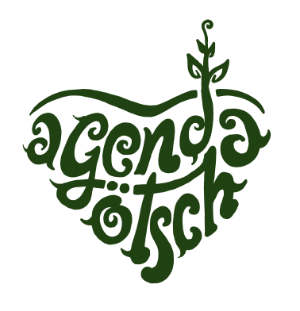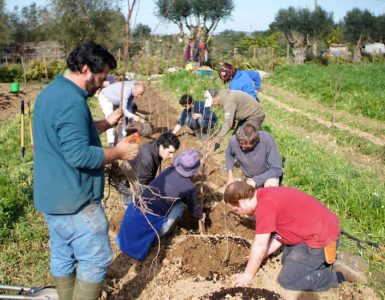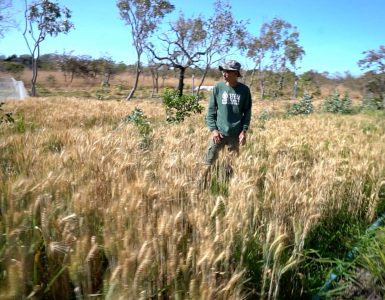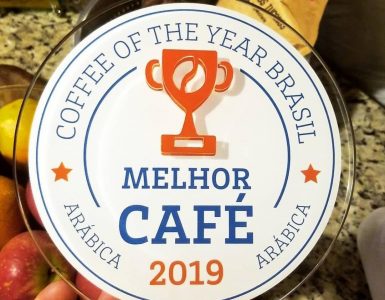A degraded pastureland transformed into a productive forest. In November 2016, Ernst Götsch chose this area at Fazenda São Sebastião to start a plot with the initial focus on banana and cassava. This article describes each step of the implementation, with the details explained by Ernst Götsch himself. The plan for the future of the area? According to Ernst, it is the establishment of an “Amazonian-Atlantic rainforest”, a good place for cambuca (plinia edulis), assai (Euterpe oleracea, kapok tree (Ceiba pentandra) and Brazil nut (Bertholletia excelsa). An example of recovery by use!
History of the area
The land has been used to grow cassava (Manihot sp) yearly. The operation was not viable because of the low productivity, and the area turned into an unmanaged pasture for cattle. It has been under these conditions of use, without maintenance (nor burning) for the past 7 years.
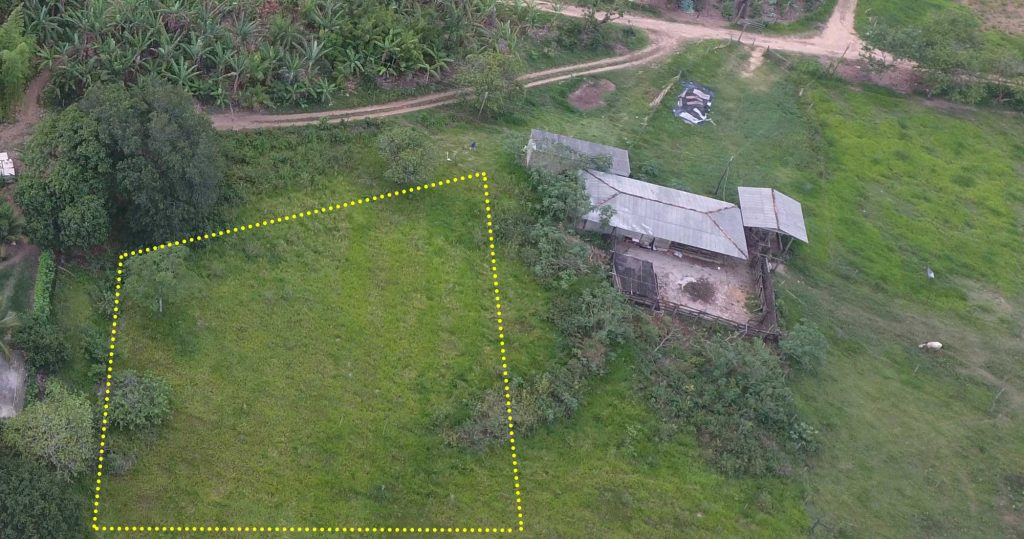
The logics of the DESIGN
The system is built upon complex consortia, which means that more than 30 different species will grow together succeeding one group after another through space and time. One important aspect is the composition of species according to their life cycle. In syntropic farming, the arrangements consider the occupation of all layers as time passes and the system evolves. Species with different life cycles can, without any problem, occupy the same space at the same time because they will grow at different rates, thus not overlapping.
In the area mentioned here, for example, banana and cassava are the representatives of the short to the medium life cycle. But in the same row were also planted assai (Euterpe oleracea), rambutan (Nephelium lappaceum), cocoa (Theobroma cacao) and cupuassu (Theobroma grandiflorum), which are part of the medium / long life-cycle group. By the 25th year, cocoa and assai will begin to be thinned out from the system to give place to the long cycle species, in this case, represented by mangosteen (Garcinia mangostana), cambucá (Plinia edulis), kapok tree (Ceiba pentandra) and Brazil nut (Bertholletia excelsa).

All these species were planted in what we call A-line. Between these lines (we call “B area”), we added mombassa (a Panicum maximum variety). At this stage, this is one of the main strategies to improve the area to the point of being good enough to support a future productive forest.
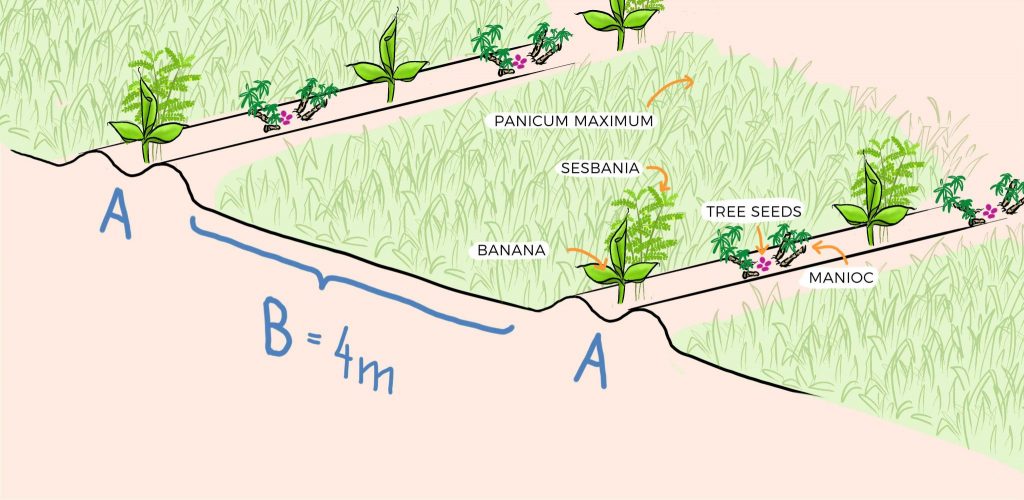
Besides not using any herbicide, the grass is cultivated intentionally. It will play the key role of biomass supplier since the beginning. The grass provides 5-6 cuts per year, a huge amount of biomass that turns into food to our trees.
Land Preparation
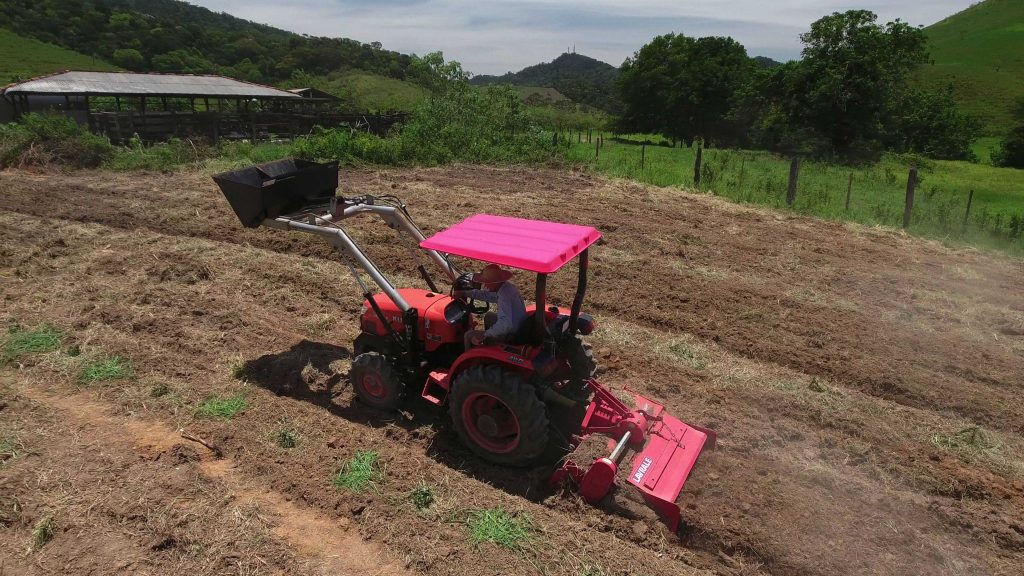
The land was plowed to break up the root-layer of the old grass (Brachiaria humidicola mainly) and also to reach down the compacted horizon (we would’ve used a subsoiler if we had one). After the plowing, we used a leveling harrow and then the rotating hoe to further fragment the soil to form the beds to our fruit trees.
There is no machinery in the agricultural market developed precisely for the purposes of this type of management. All these steps could have a more accurate result if there were some adjustments in both the tractor and its implements. The Kubota itself is great and performed really well. The changes we need is related to the paradigm in which our machinery is anchored on (more on mechanization here). A simple example of this limitation: in this type of management, the rapid regrowth of the grass is not only desired but essential to the system’s success. However, nowadays, there are no agricultural machines able to make a clean cut of suitable quality to foment the new growth in a shorter time. We need lighter machines that do not compact the soil and that are able to cut and organize the material at the same time. This is just one example, but it illustrates well the practical consequences of the paradigm shift that agricultural technology requires. For manual implantation, there is no such limitation since all these steps can be performed with simple tools like hoes, scythes, forks, etc.
Nests formation
The soil is removed from the surface which still has rhizome fragments of the grass. Save that portion on the side. The ideal would be to have machines capable of completely separating the grass and its rhizome, so that the first is not incorporated in the soil. After the separation of this layer, we kept digging until we the nest reached about 50cm deep, where we found the transition between the B and C horizons of the soil.

We didn’t do any soil lab analysis, but due to its visual appearance, texture, density and geological history, it is possible to identify some characteristics and current conditions. The soil has a good composition of clay and sand, in a favorable proportion for water retention and root penetration.
Not having access to laboratory analyzes and other edaphoclimatic data is the common daily condition of many farmers and cannot be a limiting factor.
The next step is to mix the fertilizer prepared in the proportion of five parts per volume of a nitrogen-rich organic input (we used the waste of castor oil processing plant) and one part per volume of a thermo-phosphate. Thermo-phosphate could be replaced by some rock powder that is rich in phosphates. Rock powder was also used in the grass area (B-area) between the tree lines. As it is not thermally treated, its action is slower and depends on the presence of biological activity in the soil which, in this case, will be guaranteed by the non-use of any kind of biocide.
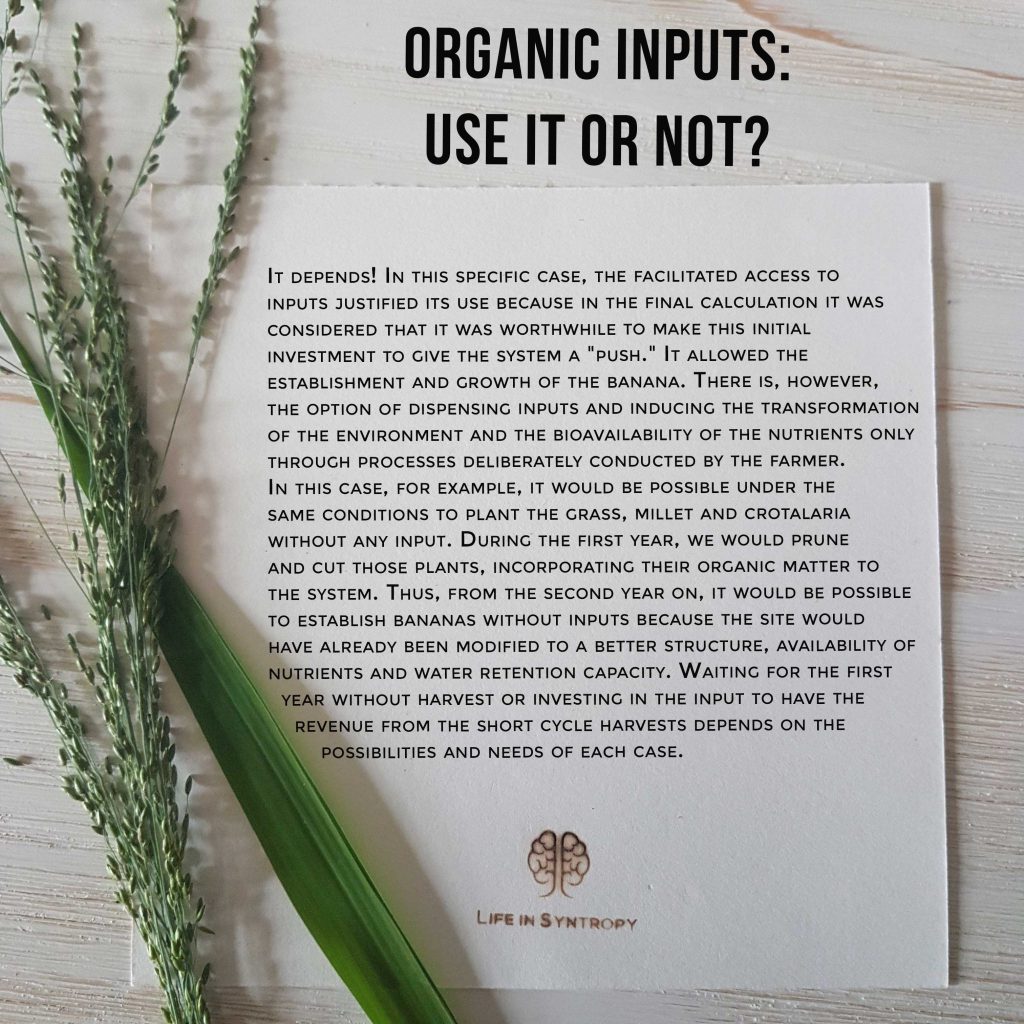
With the fertilizer homogeneously mixed with the soil, the bottommost part is replaced and pressed to remove air pockets. Then the seedling and the rest of the soil are placed. Moreover, it is recommended to place the poorest part of the soil over areas you don’t want species from the seed bank growing. To finish up, we cover the area with the organic matter from the mowing, forming a concave structure around the banana nest.

The organization of organic matter in this arrangement, which is known as a “nest” or “cradle”, protects the newly planted seedling from the direct impact of the sun as well as the soil around it, decreasing the loss of water by evaporation. It also prevents the growth of spontaneous herbs. In case of heavy rain, it avoids water runoff. The concave form promotes the flow of water to the center, benefiting the seedlings. Doing like this, the banana survives without irrigation and for up to one month without rainfall. The design of the system is foreseen to produce its own organic matter to keep a constant flow of biomass to nurture the nests.
Among the banana trees – in the same A-line – cassava was planted. Four cassava cuttings in the center, forming a double “V”. The variety used matures in 7 months, which means the ideal time to accompany the growth of the banana, as it will be harvested before they overlap. For the cassava, no fertilizer was used. It only got the organic matter already present on the site.
As cassava is planted in a double “V”, its tubers tend to grow toward the banana, thus freeing the region from the center. In this place, we will put the collection of tree seeds: Spondias mombin, Erytrina sp., soursop (Annona muricata), Hymenaea courbaril, star apple (Chrysophyllum cainito), etc. We plant about 10 different seeds, randomly chosen, ensuring that there is always an erythrina, as it plays an important role in the supply of organic matter to the system, and it also establishes a good symbiotic relationship with cacao.
Next to the banana, we planted cacao, assai, Brazil nut, inga (Inga sp), plus rambutan every second row, and mangosteen every fourth row alternated with Plinia edulis. Some of these species are in their definitive spacing, others will undergo thinning along the growth of the system, or stratification prunings to keep them longer in the system. Next to the banana we still planted 3 seeds of Sesbania grandiflora because they maintain a good symbiotic relationship with the banana. Next to the mixture of the tree seeds, we added some beans (Vigna unguiculata) because its rapid growth will provide the natural nursery for the tree seedlings.
Once we have accomplished the steps above, the soil gets covered with the remaining material of the mowing. We finish up planting Canavalia ensiformis that will also serve as biomass supplier to the system. Canavalia’s pruning also produces the beneficial effect of phytohormones release that will stimulate the growth of all neighboring species. The other advantage of planting Canavalia is that it takes over all the space at the beginning in a moment the Mombassa is still establishing itself, thus avoiding the growth of other uninteresting faster spontaneous and less productive grasses.
